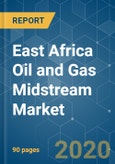The market for the East Africa oil and gas midstream market is expected to grow at a CAGR of more than 5 % during the forecast period of 2020 - 2025. Factors such as increasing production and consumption of oil and gas are expected to boost the demand for the East Africa oil and gas midstream market during the forecast period. However, instability in countries like South Sudan and Somalia are impeding growth in the market.
Key Market Trends
Transportation Sector to Witness Growth
As the stability in many of the countries in the region has increased, prosperity has led to an increase in the purchasing power of the citizens, and demand for goods like oil and gas has also seen a significant improvement and is expected to remain high in the forecast period.
Kenya to Dominate the Market
Kenya is expected to invest heavily in the expansion of the midstream sector in the country, especially in collaboration with neighboring countries. Landlocked Countries like South Sudan have signed deals to directly access Kenya's harbors to export oil and gas, which is also expected to be a beneficial deal for both countries.
Competitive Landscape
The East Africa oil and gas midstream market is moderately consolidated. The major companies include Total S.A., China National Petroleum Corporation, Petróleos de Moçambique SA, Eni S.p.A. and Kenya Pipeline Company Ltd.
Reasons to Purchase this report:
- The transportation sector in the region requires investment to grow further. Some of the projects are under construction, but due to instability, financial strains, and economic unviability, they have faltered to deliver better results.
- Countries like Mozambique and Tanzania have vast reserves of Natural gas, which, if produced economically, may act as a catalyst to further the growth in the sector and may become an opportunity for the companies working in the industry.
- Kenya has a vast coastline that can be used by neighboring countries to export their oil and gas to the world. Friendy relations with neighboring countries and increasing level of infrastructure is expected to provide growth to the market.
Key Market Trends
Transportation Sector to Witness Growth
As the stability in many of the countries in the region has increased, prosperity has led to an increase in the purchasing power of the citizens, and demand for goods like oil and gas has also seen a significant improvement and is expected to remain high in the forecast period.
- Consumption of natural gas increased in the region, by 7.93%, year on year, from 1.9 million tons of oil equivalent (mtoe), in 2015 to 1.4 mtoe, in 2018. The increase in consumption incentivizes the investors for the required increase in capacity and increases the investments in the future, thereby boosting growth in the industry.
- In 2019, the total capacity of gas pipelines in Mozambique was approximately 95471 barrels of oil equivalent per day. Mozambique-South Africa Gas pipeline with a length of 537 miles (865 km) and a capacity of 540.3 million cubic feet per year is the largest gas pipeline in the country, and such projects may build further in the forecast period.
- Hence, pipeline capacity is expected to increase slightly in the forecast period due to an increase in the production and consumption of oil and gas and rising investment in the sector.
Kenya to Dominate the Market
Kenya is expected to invest heavily in the expansion of the midstream sector in the country, especially in collaboration with neighboring countries. Landlocked Countries like South Sudan have signed deals to directly access Kenya's harbors to export oil and gas, which is also expected to be a beneficial deal for both countries.
- Lamu Port-South Sudan Pipeline is a proposed oil pipeline in South Sudan and Kenya. The pipeline would run from South Sudan oil fields to Lokichar, Kenya, where it would connect to the Kenya Crude Oil Pipeline, which ends at Kenya's Lamu Port for export. The capacity of the pipeline is expected to be around 160,000 barrels per day.
- In 2019, the total capacity of oil pipelines in Kenya was approximately 275,000 barrels of oil equivalent per day. Western Kenya Pipeline Extension with a length of 277 miles (446 km) and a capacity of 150,000 barrels of oil equivalent per day is the largest pipeline in the country.
- Oil consumption in the region increased, by 3.1%, from 604 thousand barrels per day (kbpd), in 2017 to 624 kbpd, in 2018. The increase in consumption incentivizes the investors for the required increase in capacity and increases the investments in the future, thereby boosting growth in the industry.
- Kenya oil and gas midstream industry is expected to grow significantly in the forecast period due to an expected increase in the consumption of oil and natural gas and rising investments in the midstream industry of the region.
Competitive Landscape
The East Africa oil and gas midstream market is moderately consolidated. The major companies include Total S.A., China National Petroleum Corporation, Petróleos de Moçambique SA, Eni S.p.A. and Kenya Pipeline Company Ltd.
Reasons to Purchase this report:
- The market estimate (ME) sheet in Excel format
- 3 months of analyst support
Table of Contents
1 INTRODUCTION
4 MARKET OVERVIEW
5 MARKET SEGMENTATION
6 COMPETITIVE LANDSCAPE
Companies Mentioned (Partial List)
A selection of companies mentioned in this report includes, but is not limited to:
- China National Petroleum Corporation
- Total S.A.
- Tullow Oil
- Petróleos de Moçambique SA
- Oil and Natural Gas Corporation
- Kenya Pipeline Company Ltd.
- Eni S.p.A.
Methodology

LOADING...








